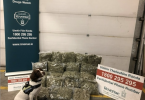On-trade declines 4.1% – Nielsen
In its latest Insight report, Nielsen tracks the continuing migration from the on-trade to the off-trade as a result of “low supermarket prices, dwindling disposable income and a changing Irish culture”.
This continuing on-trade decline is “affected by contraction in number of pubs and lower net consumption levels” set against a similar four per cent figure for growth in the off-trade.
Nielsen also breaks this on-/off-trade volume figure down by individual category. Stout volume sales indicate a five per cent decline in on-trade sales set against an eight per cent growth in off-trade.
Cider/Perry shows an eight per cent decline in on-trade set against a similar increase figure in off-trade. LADs show a four per cent decline in on-trade set against a five per cent increase in off-trade.
Lagers and No Alcohol Low Alcohol Beers are counted together as having declined in volume sales by two per cent in the on-trade while increasing by four per cent in the off-trade.
Nielsen reports a decline of five per cent in on-trade sales volume for spirits set against a six per cent growth in off-trade volumes. Within that, vodka volumes declined eight per cent in on-trade but grew five per cent in off-trade. Whiskey is down six per cent in on-trade but up five per cent in off-trade while wine sales volumes are down eight per cent in the on-trade and up just one per cent in the off-trade.
Where on- to off-trade volumes were at parity two years ago, the ratio has now swung clearly in favour of off-trade which enjoys 56 per cent of the 5.8 million hectolitre alcohol market, states Nielsen which puts multiples as the key winners of share.
Multiples growing share
The multiples channel continues to grow volume with year-on-year growth across ‘Long Alcohol’ (Lager, Stout, Ale, NABLABs, Spirit Mixers and Cider/Perry) up six per cent, spirits up eight per cent and wine up two per cent.
Nielsen reports rising levels of alcohol promotion in multiples: currently 63 per cent of volume is sold on deal for lager, for example, while for total spirits it’s 45 per cent.
“Symbol Groups also see strong year-on-year volume performance in latest data: Long alcohol (plus 15 per cent), spirits (plus 10 per cent) and wine (plus two per cent). The channel losing out in off-trade is Independents as it experiences value & volume decline, partially driven by store closures and also by higher prices: Long Alcohol volumes (volume minus nine per cent), spirits (minus three per cent) and wine (minus six per cent).”
According to Nielsen’s Shopper Trends 2012 study, consumers buying beers, wines and spirits tend to ‘only buy the essentials’ (29 per cent) or ‘look for discounts or coupons’ (22 per cent) and ‘shop in cheaper stores’ (16 per cent). 14 per cent are also ‘buying less’ while eight per cent are ‘sticking to store brands’ or ‘buying in bulk’ (four per cent).
Allocation of spare cash
Further adding to the evidence indicating continuing on-trade drift, Nielsen’s latest online survey for Q3 2010 finds Out-of-Home Entertainment at just 16 per cent ranked seventh behind saving, de-leveraging, no spare cash, holidays, clothes and home improvements for what consumers do with their spare cash after covering essential living expenses. This 16 per cent figure indicates that Ireland is trending behind the EU average for OoHE of 24 per cent and the global average of 29 per cent.
“Irish culture is changing and nights out are being swapped for nights in,” reports Nielsen.
Its Q3 survey also asked consumers what they’d done to save on household expenses. It found 58 per cent had cut down on OoHE (although this is one percentage point up on the previous quareter) while 33 per cent had switched to cheaper brands of alcohol (down one percentage point on the previous quarter).
“In terms of how these trends have changed since 2009, cutting back on Out-of-Home Entertainment was top of the saving strategy list in 2009 (69 per cent) and second in 2010 (67 per cent). Now ranking fifth (58 per cent) and though still a top saving strategy, we can see consumers have relaxed a little on this strategy in 2011 and 2012,” states Nielsen.
What will remain
Cutting down/buying cheaper brands will remain a strategy for one fifth of consumers (versus 33 per cent currently) once economic conditions improve, finds the survey which adds, “With regards to getting back out socially, only 22 per cent say they will continue cutting down on out-of-home entertainment (versus 58 per cent currently), suggesting consumers are looking forward to being able to get out again once they can afford it.
“At-home entertainment and holidays rank top as strategies consumers say they will relax spend on once economic conditions improve. Enjoying entertaining at home, in particular, has become such a big part of our consumer lifestyle and only one in 10 say they will keep this as a cost-saving strategy once economic conditions improve.”
The trend for in-home entertaining is likely to remain a strong key trend and based on Nielsen’s current trajectory the alcohol market could be split 60:40 in favour of off-trade in the next year.
It will be important for brands to consider brand loyalty and price margins as consumers continue to seek best value for money. Nielsen reckons that it will be ‘crucial’ to strike the right brand balance between promotions, price, range and innovation to drive potentially higher margin premium brands.








